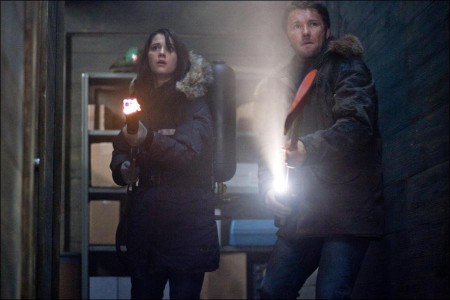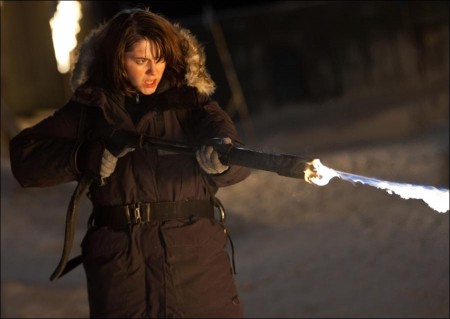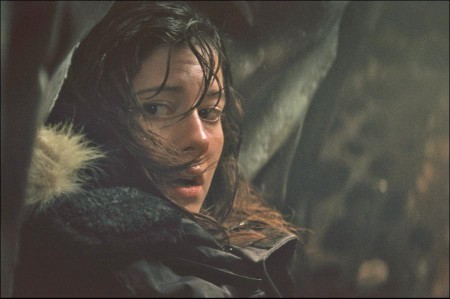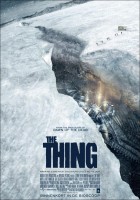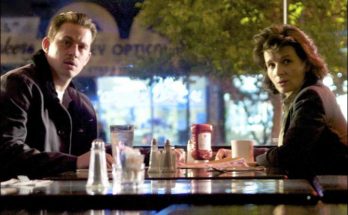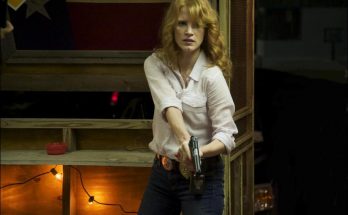Taglines: In a place where there is nothing, they found something.
Antarctica: an extraordinary continent of awesome beauty. It is also home to an isolated outpost where a discovery full of scientific possibility becomes a mission of survival when an alien is unearthed by a crew of international scientists.
The shape-shifting creature, accidentally unleashed at this marooned colony, has the ability to turn itself into a perfect replica of any living being. It can look just like you or me, but inside, it remains inhuman. In the thriller The Thing, paranoia spreads like an epidemic among a group of researchers as they’re infected, one by one, by a mystery from another planet.
Paleontologist Kate Lloyd (Mary Elizabeth Winstead) has traveled to the desolate region for the expedition of her lifetime. Joining a Norwegian scientific team that has stumbled across an extraterrestrial ship buried in the ice, she discovers an organism that seems to have died in the crash eons ago. But it is about to wake up.
When a simple experiment frees the alien from its frozen prison, Kate must join the crew’s pilot, Carter (Joel Edgerton), to keep it from killing them off one at a time. And in this vast, intense land, a parasite that can mimic anything it touches will pit human against human as it tries to survive and flourish. The Thing serves as a prelude to John Carpenter’s classic 1982 film of the same name.
Production Begins
The history of The Thing dates back to 1938, when noted science-fiction author John W. Campbell Jr. released his pulp novella “Who Goes There?,” a terrifying story that explores what happens at a research station in Antarctica when a crew of scientists unearths an alien vessel. Inspired by Campbell’s novella, Howard Hawks and Christian Nyby crafted the 1951 film The Thing From Another World. That thriller expanded upon Campbell’s exploration of group paranoia and demonstrated the story’s parallels with the Cold War period.
Thirty years later, John Carpenter returned to Campbell’s book for inspiration when he wrote and directed 1982’s The Thing. With its groundbreaking practical effects, the film, which was written by Bill Lancaster and produced by David Foster and Lawrence Turman, became a classic thriller that has inspired a generation of fans and filmmakers alike.
In 2004, producers Marc Abraham and Eric Newman had just released Universal’s blockbuster Dawn of the Dead when studio executives approached the partners about shepherding another project. Newman recalls that early conversation: “Nobody’s got a better, richer pedigree in the monster / horror zone than Universal. They said, ‘Here’s our entire library. What do you think about The Thing?’ Our first reaction to it was that you’re not going to improve upon it; you’re not going to do a better version of The Thing. It’s not a movie that could be rebooted or remade.”
After careful consideration, Abraham and Newman found themselves drawn to the story’s themes of trust and paranoia. Abraham explains: “This story has always been—in every incarnation, whether it was Carpenter’s film or back to the novella—about paranoia.” He believes those themes to be “consistently relevant because they’re about trusting—or distrusting—people that you’re stuck in a very dire situation with.”
Newman adds: “The first thing we said about this version of the movie is that its theme had to be about who you can trust and who you can’t. More than ever, we live in a time where if there is an enemy, it’s very likely that the enemy’s not someone you would suspect. The bad guys don’t wear uniforms anymore.”
Once they decided to tackle the project, the production partners needed to find a way into the story and add to what had been so cleverly done before. Explains Newman: “The only way that this project appealed to us was if it fit in the Carpenter universe in a way that was respectful but creatively consistent. What always interested me was the fate of the Norwegians who are obliquely referenced in the original movie.”
In determining the direction of this companion piece, Abraham credits his fellow producer’s encyclopedic knowledge of the source material. “Eric’s a true aficionado of these movies and has enormous respect for John Carpenter,” he says. “He’s got a photographic memory, so he knew every single beat in the movie. Once we decided that we didn’t want to remake The Thing, he came up with the idea of telling the story about what happened before we get to the dog that opens the Carpenter film.”
David Foster, who produced Carpenter’s version, joined Newman and Abraham on the project as an executive producer. He makes it clear that “this is a stand-alone picture. This is not The Thing that John Carpenter made, which I loved, and John will tell you it was the best film he ever made. This ends where that picture began. It’s pretty important that fans of The Thing know that they’re not going to see the same thing over and over again.”
When plans for the prequel of John Carpenter’s The Thing became public, Eric Heisserer launched a campaign to write the screenplay. As a longtime admirer of the property, he wanted to ensure that the film would work for him. Comments the screenwriter: “Knowing it was going to get made, I felt I had to jump on the grenade, as it were. I knew that if I could deliver something that satisfies the fan in me, hopefully, it will satisfy other fans elsewhere.”
Heisserer went to the meeting armed with ideas of what the movie should be. He wanted his version to look and feel much like an extension of Carpenter’s vision. Heisserer recalls: “I focused entirely on character and story. I focused on continuity, and I looked for surprises. I looked for opportunities that I could bring to this that we hadn’t seen before. I tried my best to do something unexpected in a world where we already know the outcome.”
Ultimately, Heisserer tapped into the story’s central themes of suspicion and distrust. He says, “I felt The Thing has always been a paranoid thriller and a case study on trust, and what you can give and what you can take.” Finding Heisserer to be a like-minded collaborator, Abraham and Newman welcomed him to the project.
The producers then approached director Matthijs van Heijningen to helm the project and found that their instincts about his suitability were spot-on. Newman describes their first meeting: “We just started talking about it and never stopped. It was like a date that never ended; next thing you knew, you were married.”
A veteran commercial director from Holland, van Heijningen makes his feature-film debut with The Thing. Abraham admits that he was sold by van Heijningen’s skills at crafting fascinating tales. “This guy is a storyteller,” Abraham commends. “So you combine that with a good visual sense. Also in his commercial work, you see he’s very passionate about character and authenticity. He was clever about what he wanted to do and how he envisioned this. He was respectful of the original; he knew it cold. I think his time has come to make a feature film, and this is a good one for him.”
“I adored the original movie; it’s one of my favorites,” van Heijningen states. “I jumped into this project as I was carried away with the idea. Sometimes I would wake up thinking, ‘Oh my God, what am I doing?’ Of course, I felt that pressure. I’ve tried to make the biggest tribute to the original movie as I can.”
Heisserer, van Heijningen and the producers began a period of intense collaboration during preproduction. Newman explains: “We looked at the set of the ruined Norwegian camp in the Carpenter movie. We thought, ‘How do we, working backwards, arrive at this? They found a freakish, burned carcass of some half man/half monster, a fire axe in the wall and a torched compound…’”
Comparing the process to an autopsy, Heisserer extrapolates: “We have relics from Carpenter’s film that inform us of what had to have happened at the Norwegian camp. But that was just forensic evidence. We had to figure out what happened and make sure that we counted for that in our story.” This painstaking attention to detail proved to be quite productive. Says the screenwriter: “Because we approached it with that level of scrutiny, it kept us all on our top game. It was excruciating, but it was also incredibly rewarding.”
To ensure accuracy, the filmmakers spent a great deal of time examining each frame of Carpenter’s film and making sure that, where appropriate, touch points and artifacts were referenced. “As fans of the movie, it was a world that we were very comfortable in,” shares Newman. “We could talk about it all day long, and we did. It was impossible for us to make this movie without acknowledging in a very real way that the Carpenter movie exists. That was the design from day one.”
The team’s attention to detail was so exacting that the filmmakers even brought in Italian composer Ennio Morricone’s classic original score (known as “Humanity [Part II]”) from the 1982 film to complement the work of this film’s composer, Marco Beltrami. Says Abraham: “There’s something incredibly haunting about that score. It almost bleeds tension and paranoia…and we knew we had to honor it.”
Who Are You?
Casting The Thing allowed the filmmakers to balance the supernatural elements of the creature tale with the more traditional aspects of storytelling. Newman explains: “When you make a horror film, you’re trying to sell a reality that doesn’t exist. You have an even greater obligation to sell the reality in the areas you can control. The performance, the characterizations and what situations are not supernatural have to be even more grounded. The cast is where you start.”
They began by making Columbia University paleontologist Dr. Kate Lloyd the central character of the story. Newman shares: “The original Carpenter movie is a very male experience. Historically, whether it’s Rosemary’s Baby or Alien or The Exorcist, there is often a feminine perspective in these films. Given that it’s 1982, it’s a man’s world. Kate is the heroine, and she provides a great way into the this tale.”
Mary Elizabeth Winstead was cast as the scientist who travels to Antarctica for an incredible chance for advancement in her field. She takes the opportunity, and it turns out to be a horrible mistake. Of the production’s leading lady, executive producer Dale commends: “I worked with Mary on Scott Pilgrim vs. the World, where she played a very different character. She’s got versatility, gravity, pathos and strength. She has everything that Kate needs to be.”
Winstead offers that she is a big fan of Carpenter’s seminal film and is honored to help bring the new story to the screen. “Having a female lead immediately differentiates us,” she says. “Kate has to be a really intelligent girl of strong will and strength of character. It’s rare to get the chance to do something where the woman gets to have that kind of power in a very realistic way.”
The situation Kate finds herself in as one of only two women among a group of male scientists allowed Winstead more layers to bring to the character. “Everyone would have a different feeling about a woman coming into the situation,” Winstead says. “And she would have certain feelings about being one of two women with all these men around. So it creates a unique dynamic between all the characters.”
Kate develops a strong bond with Carter, one of three helicopter pilots who service the camp with supplies and transport personnel. In a departure from the norm, the relationship never develops into a romantic one. Explains Newman: “The Kate and Carter dynamic, one of the central relationships in the story, was never designed to be a love story. It had more to do with building a structure between two characters who trust one another.”
In addition to providing Kate with a like-minded and trustworthy partner, the filmmakers also wanted Carter to evoke MacReady, the character played by Kurt Russell in Carpenter’s film. Carter is just the type of man who would have known and worked with the maverick pilot in ’82.
Warrior’s Joel Edgerton proved to be just the person for the job. “Joel was, first and foremost, the right actor,” says Newman. “He’s a brilliant stage and film performer and has an intelligence to him that we needed. We don’t have the time to give everyone a hero, get-to-know-you moment. We had to go with someone who brought that depth to every scene.” Though he has portrayed many characters in his career, the Australian-born Edgerton had never tackled a role quite like Carter. “I don’t think I’ve ever played a heroic character before,” he says. “None as heroic as Carter, that kind of thrown-into-the-chaos and ‘Come on, I’ll get us out of here’ type guy. I quite enjoyed it.”
Like many involved with the prequel, Edgerton remains a devoted fan of Carpenter’s movie and credits van Heijningen with his attention to detail on set. The actor notes: “Matthijs has collected a great group of actors. When I walked around the sets and saw the way the actors dressed and the way they looked, it felt dirty and true to what it would be like in that environment—a gnarly bunch of faces. He had an honest look at the way it should look and feel, and stayed true to that. And it very much stays true to the aesthetic of Carpenter’s film.
The man who brings Kate to the icy frontier is brilliant researcher Dr. Sander Halvorson, portrayed by Danish actor Ulrich Thomsen. “My character is called to Antarctica because they’ve found something in the ice,” Thomsen explains. “In the context of the story, Sander is the bad guy because he drills into the ice to get a tissue sample of the creature and he’s not supposed to do that. But he’s a scientist and can’t wait. The creature springs back to life, and madness ensues.”
Sander is directly responsible for the ensuing melee, and Thomsen was just as interested as the filmmakers were in exploring this human culpability. Thomsen sees the film as a commentary on modern-day issues. “Sander doesn’t handle it at all,” he says. “He’s trying to make sense of the whole thing and just survive, but it doesn’t go so well. You can draw some parallels to the real world on top of the horror and the entertainment of the movie.”
Eric Christian Olsen was brought aboard the production to play American Adam Goldman, Sander’s research assistant, who initially convinces Kate to come to Antarctica. He describes his character: “Adam’s incredibly good at navigating the politics of the science world, aligning himself with people who are smarter than he is, and making sure he is in the right place at the right time.” Olsen sees this film in terms of its human relationships: “There’s a monster out here, but it’s about what we’re going to do to each other under the guise of self-preservation that most interested me.”
Yet, this survival instinct is ultimately suppressed for the greater good. Newman explains: “The Thing was also about the social responsibility of these people: Escape, though it may be the best thing for me, is not the best thing for mankind. With my escape, potentially the creature escapes, and it makes short work of the entire planet.”
Lost favorite Adewale Akinnuoye-Agbaje secured the role of Jameson, a helicopter pilot who flies alongside Carter. He describes Jameson as someone who provides the humor in the movie. The British actor notes: “It’s necessary in this scary movie for someone to be light and fluffy, and that’s Jameson. He’ll crack a joke. He’s very loyal, and he’s not to be messed with.” This friendship between Jameson and Carter is based on a shared past. Akinnuoye-Agbaje explains: “They went through some pretty harrowing times together in Vietnam. It bonded them.”
With the story focused on the Norwegian camp that ultimately releases the thing into the American camp in Carpenter’s film, van Heijningen decided to add a layer of authenticity by casting actual Norwegian actors for key roles. The other filmmakers were quick to embrace his idea, and the team was able to cast some of the top actors from this region of Europe.
Newman explains: “Matthijs was pretty insistent that the cast be authentic and so he wanted to cast a lot of Norwegian actors, even if they didn’t speak great English. So with the help of DENISE CHAMIAN, our casting director, we did some pretty extensive casting in Norway.” Having Norwegians play Norwegians also offered the filmmakers more flexibility to surprise the audience. Newman continues: “If you have Hollywood movie stars in a film like this, you generally have a good idea that the movie star is not going to die or become a bad person at the end of the movie. With this cast, anything can happen to anybody…and it does.”
The production brought a number of famous Norwegians onto the film to play the crew of research scientists and support staff at the Antarctic base. Trond Espen Seim plays noted geologist Edvard Wolner, Sander’s old friend who asks him to come investigate the frozen specimen. He is joined by JØRGEN LANGHELLE as the dog keeper, Lars; JAN GUNNAR RØISE as the Spryte Snowcat driver and guide, Olav; and STIG HENRIK HOFF as Edvard’s rifle-toting right-hand man, Peder.
For Winstead, the Norwegian elements of The Thing layer on the degrees of tension. “The fact that it’s a Norwegian base adds to the sense of paranoia,” she shares. “When they’re talking to each other, you don’t know if they’re forming an alliance against you. It really builds up that tension. It’s exciting to be in a Hollywood film that has so much of a Scandinavian presence.”
Adds co-star Edgerton: “The majority of the characters are Norwegian. So you get this language clash and culture clash. It deepens the human paranoia in a film that is both human versus human and human versus creature.”
The Thing
Directed by: Matthijs van Heijningen Jr.
Starring: Mary Elizabeth Winstead, Joel Edgerton, Jonathan Walker, Kim Bubbs, Adewale Akinnuoye-Agbaje
Screenplay by: Ronald D. Moore, Eric Heisserer
Production Design by: Sean Haworth
Cinematography by: Michel Abramowicz
Film Editing by: Peter Boyle, Julian Clarke
Costume Design by: Luis Sequeira
Set Decoration by: Odetta Stoddard
Art Direction by: Patrick Banister, Jeremy Stanbridge
Music by: Marco Beltrami
MPAA Rating: R for strong creature violence and gore, disturbing images, and language.
Studio: Universal Pictures
Release Date: October 14, 2011p novella
Hits: 88
